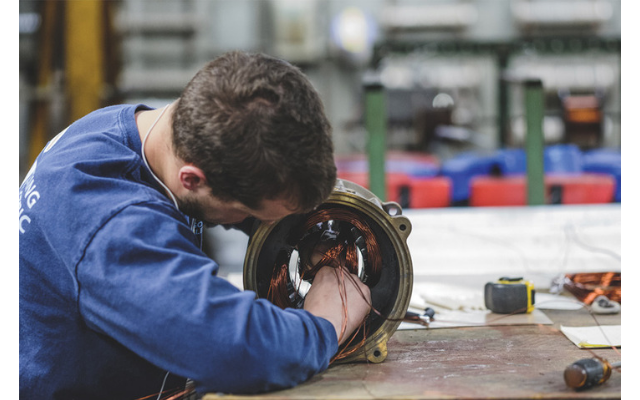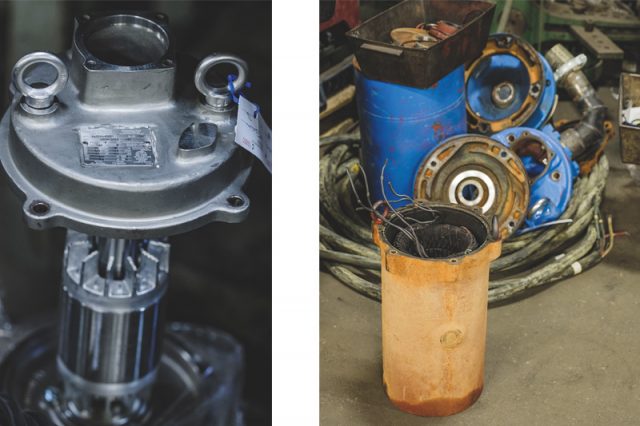Pumps are some of the most depended on pieces of equipment in the industrial field. As a result, they are also some of the most abused. It is not uncommon for many end users to run pumps until they fail, only to be shocked at the cost of maintenance after the fact.
The good news is that with a little preparation — and a little assistance from a dependable workshop — expensive repairs can be minimized or avoided altogether. Following are some of the most important contributing factors to a successful preventive pump maintenance regimen.
The cost of cables
Once a pump arrives at the workshop, one of the first things a mechanic checks is the pump cable integrity. A pump should never be lifted directly by its power cable, but it happens, and the resulting damage can lead to water intrusion. Cables should be regularly checked for cuts, abrasions and internal breaks. The strain relief apparatus on larger pumps should always be employed and never removed.
A deeper analysis
A reputable motor shop will have equipment on hand to test a pump’s winding, insulation and overall motor integrity without taking the unit apart. Ideally, the technician will use a motor analyzer during this process because it provides greater accuracy than a multimeter. By reading the feedback, a mechanic can quickly assess how extensive the repairs will be and how gently the pump should be handled. For example, if the winding is bad, a mechanic knows that he or she can proceed without being delicate since damage has already been done.
The motor analyzer functions by sending different levels of current through the pump’s motor at different frequencies. The technician may start by sending a constant sine wave through the unit. If the motor checks out under a constant current level, the motor analyzer can then send varying levels of current through the pump to simulate the function of a variable frequency drive. The varying pulse widths — 120 variations per second, to be exact — will quickly determine the motor’s integrity.
The process of using the proper testing equipment can prevent unnecessary maintenance down the road. It can help a mechanic determine whether a pump needs an expensive motor rewind or simply a new cable, which can save the customer thousands of dollars in repair costs.
It is important to note that a typical end user or distributor will not have a motor analyzer on hand. Much of the same data can be gathered with a multimeter or megger tester, but not to the same degree of accuracy. For the best preventive maintenance results, find a reputable motor shop that has high-end diagnostic equipment at its disposal.
Have a routine
The bearings in most pumps contain grease that retains its integrity for four to five years of continuous use. Once a pump hits the three- to four-year mark, it is good practice to change the grease, bearings and mechanical seal. Without this routine maintenance, the bearings could fail, leading to damage in the shaft and winding. The resulting repairs can reach almost triple the cost of the routine component replacements.
Be sure to consult with a mechanic about which components to use. Depending on the application, a grease with a longer life or higher temperature resistance may be preferable. Also make sure the optimal bearings are used for the pump in question. The correct bearing will keep grease packed in while expelling debris. And if by chance the mechanical seal gets breached, by the time the oil seal indicator gives warning that water has egressed into the pump chamber, the pump’s bearings will still run.
Know the pump and the application
Almost a quarter of the failures seen in Tsurumi’s workshop are caused by pumps being used in the wrong application. Customers often are not sure about the content of the fluid being pumped, which can lead to disaster. For example, an end user may assume that water is clean when it contains sand and rock particulate. If the wrong pump is used to move aggregate slurry, the resulting damage can be expensive.
A pump capable of moving solids-laden water will be designed with an oil shaft seal as well as a mechanical seal to keep debris away from the mechanical parts. A superior pump in that regard may also feature a throated impeller, which covers the shaft to a greater degree instead of the impeller hanging off the bottom. A good mechanic can help check for these features.
Mining is one of the toughest applications a pump can encounter. If pumping slurry in a mine, be aware of different coatings available that can minimize damage. A silicon carbide or ceramic-filled coating, for example, can be brushed on as an epoxy and extend the life of a pump’s surface better than most other materials. During routine maintenance in the future, a knowledgeable mechanic can assess the coating for color changes and detect how much wear has occurred. The mechanic can then determine whether the coating is doing what it is designed to do or if it is unnecessary for the application.
If using a pump in a water feature, have a screen in place on the inlet to ensure that plant life and other solid materials cannot enter the pump and cause damage. For three-phase water feature pumps, make sure it is running in the right direction — if it is not, it will still run, but not as efficiently.
Regardless of the application or surroundings, always treat the pump with respect. Some of the most avoidable failures occur when end users discard foreign material in or around the pump. From foam ear plugs and rubber gloves, to nylons and bed sheets — even the most resilient cutter pumps can fall prey to these materials if they come in contact with the impellers in too high a concentration.
Have a backup
Finally, one of the simplest preventive maintenance tips requires no tools or technicians at all. Some operators are afraid to pull a pump from an application because of the resulting downtime. But by investing in a backup unit, work can continue after even the most catastrophic failures.
In some cases, rotating between two units can mean the difference between spending $8,000 on routine maintenance and spending upwards of $40,000 on the complete rebuild of a pump.
Leave it to the pros
Any pump can fail at any time, no matter the amount of time and resources put into maintaining it, but having the expertise of a trusted workshop on hand can minimize downtime to an impressive degree. When in doubt, trust the advice of a good mechanic and make sure all repairs are made with genuine parts from the manufacturer — this is the only way to guarantee that a pump will meet its original factory specifications. What may seem like a sizeable investment at the time will most likely pale in comparison to the money and time spent replacing equipment outright.
Mike Klimes is an application engineer for Tsurumi America, a division of Tsurumi Manufacturing, with more than 20 years of engineering and manufacturing experience. He is responible for solving customer issues with in-depth performance analysis through the complete life cycle of pumping applications.
Tsurumi America has provided pumping technology in construction, civil engineering, mining, industrial wastewater, domestic wastewater, sewage treatment, flood control and scenery creation fields for more than 35 years. For more information, visit tsurumipump.com or call 630-793-0127.






Thank you for this attractive and informative blog. This content is about effectively maintaining pumps. it helped me to buy a pump from Antlia works.
Thank you for sharing this blog. This content is about effectively maintaining pumps. it helped me to buy a pump from Antlia works.